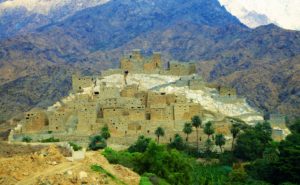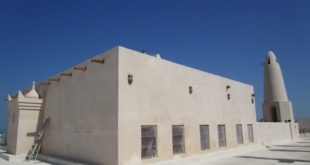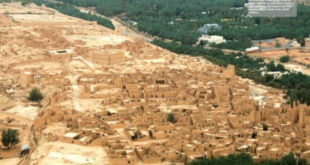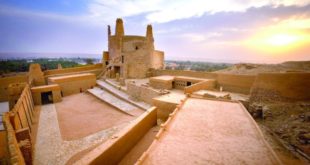Dhi Ain Village
local community
B- legal status:
A heritage site subject to the Kingdom’s Antiquities, Museums and Urban Heritage System
A restored ancient mosque is included in the list of ancient mosques in the Sultanate of Oman and is protected under the Cultural Heritage Protection Law- Who is responsible:
General Authority for Tourism and National Heritage
The village of Dhi Ayn is located at the foot and top of a white rocky mountain of medium height and its natural terrain is rugged. The village is surrounded by a number of mountainous heights from the northern, southern and eastern sides, and it overlooks Wadi Rash from the western side.. It is about 24 km. The village includes a group of compact, adjacent residential buildings that are stacked on top of each other in a creative and gradual geometric formation according to the sloping nature of the mountainous land on which it is built. The external appearance of the village overlooks the ocean as if it were a single castle consisting of a group of houses stacked on top of each other.. This residential complex is distinguished by the construction of a number of houses in the form of pyramidal towers tilted at the top, which increases its beauty and suggests fortification in the overlay of its architectural masses.. It is noted that the construction craftsmen have been creative in dealing with the nature of the natural, rocky, sloping ground, as the facades of the houses have been reinforced with stone walls similar to the building stones used for the buildings themselves, so that the heights of the buildings appear higher than they really are and their interior designs.. Most of the houses in this beautiful community consist of one or two floors and extend in harmony with the nature of the land by increasing the areas of the buildings and the number of their floors or parts thereof, up to four floors.. The building was built using a homogeneous type of stacked volcanic stones of varying sizes, shapes, and colors. They were installed on top of each other in an artistic manner that required high professional expertise. They were plastered from the inside with a thick layer of clay and mud.. It was also noted that the same stones were used in decorative formations at the top of the facades of buildings, which are protrusions at the edge of the facade mounted on stones. White quartz stone was used in a number of them to create triangular decorative formations.. The roofs were also built using the trunks of juniper trees, with a layer of tree branches on top of them, and clay and mud on top.. It was also noted that there were a number of decorations decorating the windows and doors of a number of houses. The layout of the village appears in its beautiful traditional form, harmonious with the sloping rocky ground. Stone was used to build the stairs, corridors and narrow alleys, and they were also paved, and fences were built to protect road users.. The village of Dhi Ain is considered one of the most beautiful and unique urban examples of fortified villages in Al-Baha. It is famous for growing types of fruits and basil, in addition to the quality of its handicrafts
B- Photographic documents and/or films
A restored ancient mosque is included in the list of ancient mosques in the Sultanate of Oman and is protected under the Cultural Heritage Protection Law- Which includes niches with arches and columns on either side, surrounded by panels carved or elaborately molded from stucco.
The village of Dhi Ain is considered one of the most important heritage villages in the Arabian Peninsula. It belongs to the villages of Tihama, and the beginning of its establishment dates back to the tenth century AH. The village was given this name in reference to the spring that originates from the mountains and passes through them..
5- save status
The village has been restored and work is underway to repurpose it
B- Responsible for conservation / preservation:
General Authority for Tourism and National Heritage
A restored ancient mosque is included in the list of ancient mosques in the Sultanate of Oman and is protected under the Cultural Heritage Protection Law- Stages of conservation / preservation:
Under rehabilitation
Sheikh Abdullah bin Bashir bin Muhammad Al-Saqri used to hold teaching sessions on the principles of jurisprudence, the sciences of belief, and the principles of rulings at the Shawadnah Mosque in the winter.- Means of conservation / preservation:
The village has been restored and work is underway to repurpose it
E- Management and/or action plans:
Working to rehabilitate the village
 Google+
Google+





